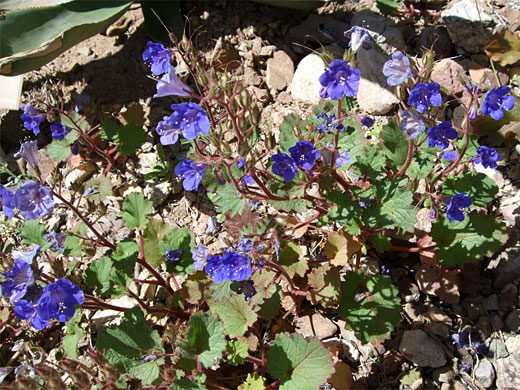Common names:
Desert bluebell, California bluebell, desert bell
Family:
Scientific name:
Phacelia campanularia
Main flower color:
Range:
Southeast California, west Arizona - Mojave and Sonoran deserts
Height:
Between 8 and 24 inches
Habitat:
Deserts; sandy flats, exposed areas, roadsides
Leaves:
Oval-shaped or nearly round, with toothed, slightly lobed edges, red veins and red stalks
Season:
February to April
Phacelia campanularia produces stout, branched, reddish stems and curly-edged green leaves, topped by bell-shaped flowers with five, rounded petals, mostly fused together, colored blue when first open, gradually becoming purplish, often with a few white streaks. The five stamens are quite long, projecting beyond the corolla, and bear prominent, light colored anthers. A divided style also extends out above the lobes. All of the plant is covered by short, bristly, glandular hairs.
This species is common across the Sonoran and Mojave deserts. Two varieties are var campanularia, which has a narrow corolla with widely spreading lobes (and the length of the corolla is generally less than the width), and var vasiformis, where the corolla is funnel-shaped, and its length is generally more than the width. The former variety is found towards the west, the latter more to the east.
This species is common across the Sonoran and Mojave deserts. Two varieties are var campanularia, which has a narrow corolla with widely spreading lobes (and the length of the corolla is generally less than the width), and var vasiformis, where the corolla is funnel-shaped, and its length is generally more than the width. The former variety is found towards the west, the latter more to the east.
All Contents © Copyright The American Southwest | Comments and Questions | Contribute | Site Map



